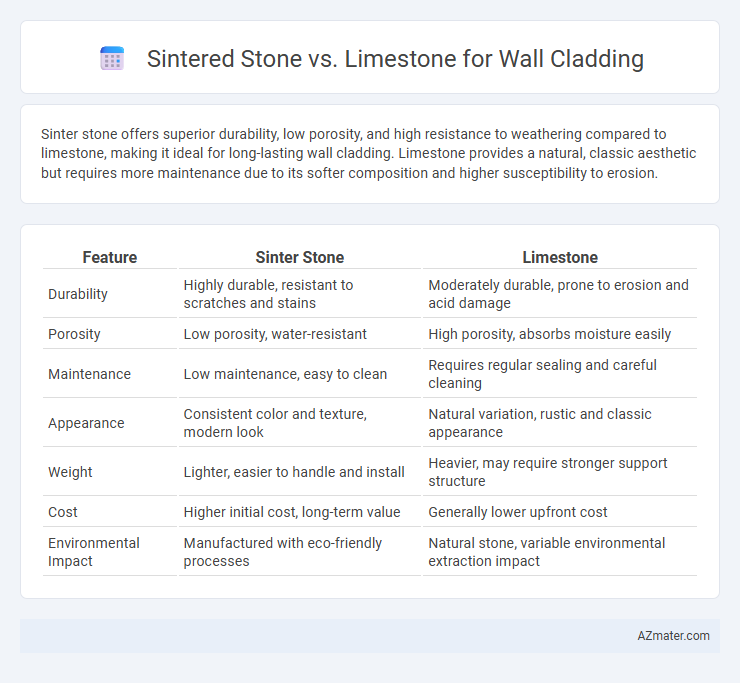Sinter stone offers superior durability, low porosity, and high resistance to weathering compared to limestone, making it ideal for long-lasting wall cladding. Limestone provides a natural, classic aesthetic but requires more maintenance due to its softer composition and higher susceptibility to erosion.
Table of Comparison
| Feature | Sinter Stone | Limestone |
|---|---|---|
| Durability | Highly durable, resistant to scratches and stains | Moderately durable, prone to erosion and acid damage |
| Porosity | Low porosity, water-resistant | High porosity, absorbs moisture easily |
| Maintenance | Low maintenance, easy to clean | Requires regular sealing and careful cleaning |
| Appearance | Consistent color and texture, modern look | Natural variation, rustic and classic appearance |
| Weight | Lighter, easier to handle and install | Heavier, may require stronger support structure |
| Cost | Higher initial cost, long-term value | Generally lower upfront cost |
| Environmental Impact | Manufactured with eco-friendly processes | Natural stone, variable environmental extraction impact |
Understanding Sinter Stone and Limestone
Sinter stone, a dense, durable material formed through high-temperature sintering of natural minerals, offers exceptional resistance to weathering and stains, making it ideal for exterior wall cladding. Limestone, a sedimentary rock primarily composed of calcium carbonate, provides a classic, natural appearance with moderate durability but requires sealing to prevent water absorption and erosion. Understanding the composition and maintenance requirements of sinter stone and limestone is crucial for selecting the appropriate cladding material based on environmental exposure and aesthetic preferences.
Key Properties Comparison
Sinter stone offers superior durability and weather resistance compared to limestone, making it ideal for exterior wall cladding in harsh climates. Limestone provides a natural, aesthetic appeal with its softer texture and warm tones but is more porous and susceptible to erosion and staining. Both materials vary significantly in hardness, with sinter stone typically ranking higher on the Mohs scale, ensuring greater scratch resistance and longevity for building facades.
Aesthetic Differences
Sinter stone offers a sleek, contemporary appearance with subtle color variations and a smooth texture ideal for modern wall cladding designs. Limestone presents a more natural, rustic aesthetic with earthy tones and a porous surface that enhances traditional and classic architectural styles. The visual contrast between sinter stone's uniform finish and limestone's organic imperfections defines their distinct aesthetic appeal in wall cladding applications.
Durability and Longevity
Sinter stone offers superior durability and longevity compared to limestone due to its dense, non-porous structure that resists weathering, erosion, and staining over time. Limestone, being a softer sedimentary rock, is more prone to chipping, erosion, and chemical wear, especially in acidic environments. For wall cladding applications, sinter stone's enhanced hardness and low water absorption contribute to a longer lifespan with minimal maintenance.
Installation Requirements
Sinter stone requires precise cutting tools and professional handling due to its dense and durable composition, ensuring a seamless and long-lasting wall cladding installation. Limestone, being softer and more porous, necessitates careful sealing and moisture protection during installation to prevent damage and staining. Both materials demand skilled labor, but sinter stone typically involves higher installation costs due to its strength and specialized equipment requirements.
Maintenance and Cleaning
Sinter stone offers superior resistance to stains and requires minimal maintenance, making it ideal for wall cladding in high-traffic or outdoor areas. Limestone is more porous and prone to staining, necessitating regular sealing and gentle cleaning with pH-neutral products to preserve its appearance. Both materials benefit from routine dusting and avoiding harsh chemicals to extend their longevity and aesthetic appeal.
Cost Analysis
Sinter stone wall cladding typically incurs higher upfront costs due to its advanced manufacturing process and enhanced durability compared to limestone. Limestone remains a cost-effective option with lower material and installation expenses but may require more maintenance over time, increasing total lifecycle costs. Evaluating long-term value, sinter stone offers better resistance to weathering and stains, potentially reducing future repairs and replacements.
Environmental Impact
Sinter stone exhibits a lower environmental impact compared to limestone for wall cladding due to its energy-efficient manufacturing process and minimal quarrying requirements. Limestone extraction contributes to habitat disruption and increased carbon emissions from blasting and transportation. The durability and low porosity of sinter stone also reduce maintenance needs, further decreasing its lifecycle environmental footprint.
Popular Applications in Wall Cladding
Sinter stone and limestone both serve as popular materials in wall cladding, with limestone favored for its natural, earthy appearance and durability in exterior and interior facades. Sinter stone, known for its high density and resistance to weathering, is widely used in commercial buildings and modern architectural designs where strength and sleek aesthetics are crucial. Both materials offer versatility in texture and color, making them ideal for enhancing the visual appeal and functional performance of residential, commercial, and public spaces.
Choosing the Right Material for Your Project
Sintered stone offers superior durability, low porosity, and resistance to weathering, making it ideal for exterior wall cladding in harsh climates. Limestone provides a natural, warm aesthetic but requires sealing and regular maintenance due to its softness and higher porosity. Assess project-specific factors such as exposure, budget, and desired finish to select between sintered stone's longevity and limestone's classic appeal.

Infographic: Sinter stone vs Limestone for Wall Cladding
 azmater.com
azmater.com